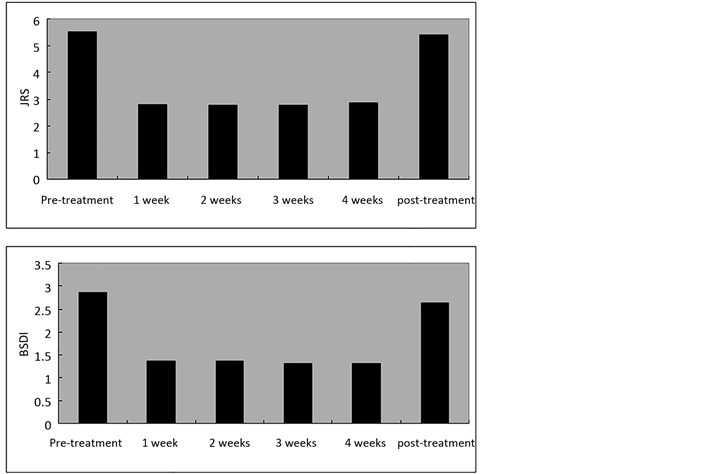International Journal of Psychiatry and Neurology
Vol.06 No.03(2017), Article ID:21782,6
pages
10.12677/IJPN.2017.63008
A Retrospective Study on the Therapeutic Effect of Dextromethorphan on Essential Blepharospasm
Xuesheng Zheng
Department of Neurosurgery, Xin Hua Hospital, Affiliated to Shanghai Jiao Tong University School of Medicine, Shanghai

Received: Aug. 3rd, 2017; accepted: Aug. 17th, 2017; published: Aug. 23rd, 2017

ABSTRACT
Background: Blepharospasm is a focal dystonia characterized by intermittent or continual involuntary contractions of the facial muscles around both eyes. It causes frequent eyelid closure and visual disturbance. The current therapies for blepharospasm are not satisfactory. Here is a retrospective study to analyze the therapeutic effect of dextromethorphan on blepharospasm. Methods: This retrospective study included 22 patients with blepharospasm. They were treated with dextromethorphan, 30 mg orally three times a day for 4 weeks. The effect of dextromethorphan on essential blepharospasm was evaluated using Jankovic Rating Scale (JRS) and Blepharospasm Disability Index (BSDI). Results: Before treatment, the baseline JRS score was 5.55 ± 1.10 points, and the BSDI score was 2.87 ± 0.59 points. After 1 week of dextromethorphan treatment, the JRS score decreased to 2.82 ± 0.85 points and the BSDI score to 1.36 ± 0.58 points. In the following 3 weeks of dextromethorphan treatment, the JRS and BSDI scores kept in a steady state. One week after the dextromethorphan treatment, the JRS (5.41 ± 1.01 points) and BSDI (2.63 ± 0.64 points) scores returned to the pre-treatment baseline level. Conclusion: We found that dextromethorphan is effective to relieve the symptoms in patients with blepharospasm, and this finding might imply an alternative treatment option to essential blepharospasm.
Keywords:Essential Blepharospasm, Dextromethorphan
右美沙芬治疗特发性眼睑痉挛的回顾性分析
郑学胜
上海交通大学医学院附属新华医院神经外科,上海
收稿日期:2017年8月3日;录用日期:2017年8月17日;发布日期:2017年8月23日

摘 要
背景:眼睑痉挛是一种局限性肌张力障碍,患者眼睛周围的肌肉频繁不自主收缩导致眼睑闭合和视力障碍。目前治疗眼睑痉挛的效果并不是很理想。本文是一项右美沙芬对眼睑痉挛疗效的回顾性研究。方法:回顾性研究包括22例特发性眼睑痉挛,患者接受右美沙芬治疗,30mg 每天三次口服,采用扬科维奇评分(Jankovic Rating Scale, JRS)和眼睑痉挛的残疾指数(Blepharospasm Disability Index, BSDI)评价疗效。结果:右美沙芬治疗前基线JRS评分是5.55±1.10分,BSDI基线评分为2.87±0.59。右美沙芬治疗1周后,JRS评分下降到2.82 ± 0.85分,BSDI下降到1.36 ± 0.58分。在接下来的3周的治疗,JRS和BSDI得分保持在一个稳定的状态。停止右美沙芬治疗一周后,JRS评分(5.41 ± 1.01分)和BSDI评分(2.63 ± 0.64分)回到治疗前的基线水平。结论:本研究发现右美沙芬对眼睑痉挛患者有效,这一发现可能意味着另一种治疗选项。
关键词 :特发性眼睑痉挛,右美沙芬

Copyright © 2017 by author and Hans Publishers Inc.
This work is licensed under the Creative Commons Attribution International License (CC BY).
http://creativecommons.org/licenses/by/4.0/


1. 引言
眼睑痉挛是一种局限性肌张力障碍,患者眼睛周围的肌肉频繁不断的不自主收缩,导致眼睑闭合和视力障碍,影响日常生活和工作。严重的眼睑痉挛可能引起交通事故 [1] 。由于特发性眼睑痉挛的发病机制不明,目前的治疗主要是缓解症状 [2] 。许多治疗方法,如生物反馈、催眠、针灸、心理疗法都已经在临床试用过,但收效甚微。一些药物如左旋多巴,丁苯那嗪、安定、氯硝西泮、碳酸锂、哌啶醇、苯妥英、盐酸金刚烷胺也一直临床试用,以期缓解痉挛症状,但效果很差 [3] 。根据临床经验,我们在临床实践中使用右美沙芬治疗眼睑痉挛,发现右美沙芬对眼睑痉挛患者缓解症状有效,因此我们在此回顾性分析该系列病例。
2. 病例和方法
病例:2014年一位男性眼睑痉挛患者向我们反映,他偶然发现,当他得了上呼吸道感染后服用非处方镇咳药右美沙芬,其眼睑痉挛症状得到明显减轻。2015年1月至2016年12月期间,22例特发性眼睑痉挛患者在我科门诊接受右美沙芬治疗,30 mg每日三次口服,4周为一疗程。十五女性患者,七个男性患者,年龄在42至67岁之间(平均58.3岁),均由神经外科专家排除其它疾患确诊为特发性眼睑痉挛,排除严重内脏功能障碍和精神病,排除颅神经手术史。右美沙芬治疗期间,禁用其他用药,除非高血压、糖尿病患者长期使用的降压、降糖药。治疗前一周、治疗过程中每一周及治疗后一周,根据扬科维奇评分(Jankovic Rating Scale, JRS)和眼睑痉挛的残疾指数(Blepharospasm Disability Index, BSDI),评价眼睑痉挛的程度。同时记录任何副作用。
JRS:该评分表由神经外科医生评估 [4] ,该量表包括严重程度和频率两方面。严重程度方面,得分0意味着没有痉挛,得分1意味着只有在外部刺激下才出现眨眼增加,得分2意味着轻度自发的眼睑抽动,得分3意味着中度痉挛,得分4意味着严重痉挛。作为频率方面,0分意味着没有痉挛,1分意味着增加的闭眼频率,2分意味着眼睑轻度抽搐,但持续 < 1秒,得分3意味着眼睑痉挛持续 > 1秒,4分意味着因持续闭目而功能性失明。因此,JRS总分为8。
BSDI:BSDI是患者自评量表 [4] 。它包括6个项目,即驾驶车辆,阅读,看电视,购物,散步和做日常活动。对于每一个项目,得分0意味着没有障碍,得分1意味着轻微的障碍,得分2意味着中度障碍,得分3意味着严重的障碍,得分4意味着完全不能做这项活动。如果一个项目不适用于一个病人,例如,一个没有驾驶执照的病人“驾驶车辆”的项目,该项目应该被删除。最后分数是所有适用活动得分的平均分数。因此,BSDI得分范围是0~4。
统计分析:t检验和方差分析用于定量数据分析。P < 0.05者有统计学意义。
3. 结果
表1列明了22例眼睑痉挛患者在不同时间点的JRS和BSDI评分。
右美沙芬治疗前我们检测了患者的基线评分,JRS基线评分是5.55 ± 1.10分,BSDI基线评分为2.87 ± 0.59。
表1. 22例特发性眼睑痉挛患者接受右美沙芬治疗的JRS和BSDI评分

Figure 1. The mean JRS and BSDI scores of essential blepharospasm patients treated with dextromethorphan
图1. 特发性眼睑痉挛患者右美沙芬治疗的平均JRS和BSDI评分
右美沙芬治疗1周后,JRS评分下降到2.82 ± 0.85分,BSDI下降到1.36 ± 0.58分。与治疗前基线相比,JRS (P < 0.05)和BSDI (P < 0.05)的改善都具有统计学意义。
如图1所示,在接下来的3周的治疗,JRS和BSDI得分保持在一个稳定的状态,没有显著性改变 (P > 0.05)。
停止右美沙芬治疗一周后,JRS评分(5.41 ± 1.01分)和BSDI评分(2.63 ± 0.64分)回到治疗前的基线水平。
本组无严重并发症。两名患者有轻度头晕,1例有轻度恶心,这些副作用是可耐受的,并未导致右美沙芬停药。
4. 讨论
由于特发性眼睑痉挛的发病机制尚不清楚,当前治疗的主要目的是缓解痉挛症状。
最常见的治疗方法是A型肉毒毒素注射。肉毒杆菌毒素治疗特发性眼睑痉挛的短期表现是很成功的,其不良事件少见。但是肉毒杆菌神经毒素对于机体免疫系统是一种外源性抗原,会引发特异性抗体的产生,最终肉毒杆菌毒素将被中和。因此,肉毒杆菌神经毒素注射一般开始是有效的,但会在几年内耐药 [5] 。
特发性眼睑痉挛的手术治疗效果不理想。脑深部电刺激(DBS),部分面神经切断术,面肌悬吊术都曾在临床尝试,在某种程度上缓解症状,但不能治愈 [6] 。
如上所述,各种口服药物的症状缓解效果非常有限。我们偶然从临床实践发现,镇咳药右美沙芬能抑制眼睑痉挛。这可能成为非手术治疗的新选择,当然需要未来前瞻性的临床试验。
作为镇咳药,右美沙芬可能是作用于中枢神经系统以提高咳嗽阈值 [7] 。它能减轻谷氨酸诱导的神经毒性,对缺血引起的脑损伤具有神经保护作用 [8] 。右美沙芬还有许多其他医疗应用,如疼痛缓解,精神疾病治疗,以及成瘾的治疗 [9] 。
右美沙芬的药理作用十分广泛。它是一种非选择性5-羟色胺再摄取抑制剂和σ-1受体激动剂,也是一个低亲和力的非竞争性NMDA受体(NMDA受体)拮抗剂 [10] 。它能抑制突触前末梢投射到二级神经元的谷氨酸释放 [11] 。虽然右美沙芬在中枢神经系统中具有广泛的药理作用,但确切的作用点和作用机制尚不完全清楚。已被证明在眼睑痉挛患者中,很多大脑区域功能异常,包括基底神经节,皮层和小脑。然而,目前尚不清楚这些部位的功能变化是否是该病的病因或结果 [2] 。参与特发性眼睑痉挛发病的神经回路和确切机制尚不明确,因此研究右美沙芬如何治疗眼睑痉挛还有很大的空间。
作为一项回顾性分析,本文存在局限:只有治疗前后的自身对照,没有随机对照。在将来的前瞻性研究中需要克服该缺陷。
5. 结论
本研究发现右美沙芬对眼睑痉挛患者有效,并且无明显严重副作用。这一发现可能意味着另一种治疗选项。
基金项目
本研究得到上海市科委项目(14DZ1930303)的资助。
文章引用
郑学胜. 右美沙芬治疗特发性眼睑痉挛的回顾性分析
A Retrospective Study on the Therapeutic Effect of Dextromethorphan on Essential Blepharospasm[J]. 国际神经精神科学杂志, 2017, 06(03): 44-49. http://dx.doi.org/10.12677/IJPN.2017.63008
参考文献 (References)
- 1. Huang, X.F., Wang, K.Y., Liang, Z.H., Du, R.R. and Zhou, L.N. (2015) Clinical Analysis of Patients with Primary Blepharospasm: A Report of 100 Cases in China. European Neurology, 73, 337-341. https://doi.org/10.1159/000381707
- 2. Valls-Sole, J. and Defazio, G. (2016) Blepharospasm: Update on Epidemiology, Clinical Aspects, and Pathophysiology. Frontiers in Neurology, 7, 45. https://doi.org/10.3389/fneur.2016.00045
- 3. Coscarelli, J.M. (2010) Essential Blepharospasm. Seminars in Ophthalmology, 25, 104-108. https://doi.org/10.3109/08820538.2010.488564
- 4. Jankovic, J., Kenney, C., Grafe, S., Goertelmeyer, R. and Comes, G. (2009) Relationship between Various Clinical Outcome Assessments in Patients with Blepharospasm. Movement Disorders: Official Journal of the Movement Disorder Society, 24, 407-413. https://doi.org/10.1002/mds.22368
- 5. Mezaki, T., Kaji, R., Brin, M.F., Hirota-Katayama, M., Kubori, T., Shimizu, T., et al. (1999) Combined Use of Type A and F Botulinum Toxins for Blepharospasm: A Double-Blind Controlled Trial. Movement Disorders: Official Journal of the Movement Disorder Society, 14, 1017-1020. https://doi.org/10.1002/1531-8257(199911)14:6<1017::AID-MDS1018>3.0.CO;2-3
- 6. Sung, Y., Nam, S.M. and Lew, H. (2015) Clinical Outcomes of Individualized Botulinum Neurotoxin Type A Injection Techniques in Patients with Essential Blepharospasm. Korean Journal of Ophthalmology: KJO, 29, 115-120. https://doi.org/10.3341/kjo.2015.29.2.115
- 7. Karttunen, P., Tukiainen, H., Silvasti, M. and Kolonen, S. (1987) Antitussive Effect of Dextromethorphan and Dextromethorphan-Salbutamol Combination in Healthy Volunteers with Artificially Induced Cough. Respiration; International Review of Thoracic Diseases, 52, 49-53. https://doi.org/10.1159/000195303
- 8. Bokesch, P.M., Marchand, J.E., Connelly, C.S., Wurm, W.H. and Kream, R.M. (1994) Dextromethorphan Inhibits Ischemia-Induced c-fos Expression and Delayed Neuronal Death in Hippocampal Neurons. Anesthesiology, 81, 470-477. https://doi.org/10.1097/00000542-199408000-00026
- 9. Huang, E.Y., Liu, T.C. and Tao, P.L. (2003) Co-Administration of Dextromethorphan with Morphine Attenuates Morphine Rewarding Effect and Related Dopamine Releases at the Nucleus Accumbens. Naunyn-Schmiedeberg’s Archives of Pharmacology, 368, 386-392. https://doi.org/10.1007/s00210-003-0803-7
- 10. Chen, S.L., Hsu, K.Y., Huang, E.Y., Lu, R.B. and Tao, P.L. (2011) Low Doses of Dextromethorphan Attenuate Morphine-Induced Rewarding via the Sigma-1 Receptor at ventral Tegmental Area in Rats. Drug and Alcohol Dependence, 117, 164-169. https://doi.org/10.1016/j.drugalcdep.2011.01.013
- 11. Ohi, Y., Tsunekawa, S. and Haji, A. (2011) Dextromethorphan Inhibits the Glutamatergic Synaptic Transmission in the Nucleus Tractus Solitarius of Guinea Pigs. Journal of Pharmacological Sciences, 116, 54-62. https://doi.org/10.1254/jphs.11008FP
